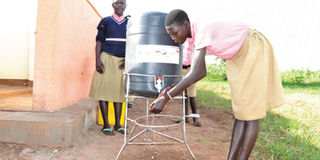Pupils promote hygiene in rural Oyam schools

Sarah Kwansara Konge, a member of the health club at Amaji Primary School in Oyam District demonstrates how to wash hands. Photo by Dan Wandera
What you need to know:
Rural pupils in Oyam District are becoming change agents through transferring sanitation skills acquired at school to their homes to reduce spread of diseases and stigma around menstruation.
At 15, Felister Achieng, a Primary Seven pupil at Anyeke Primary School in Oyam Town Council, boasts of being a leader of her school’s Health Club. But most importantly, Achieng boasts of exemplary leadership. “As a prefect, my first duty when I arrive at school is to ensure that all the litter is properly disposed of at the rubbish pit before the teachers instruct me to do so. I do not have to wait for the other pupils to pick the rubbish. I also ensure that all the hand washing facilities placed at the school latrines are filled with water,” she says.
Achieng, in coordination with other members of the school Health Club, clean the school and ensure the young children get firsthand information on how to properly use the latrine and wash hands after visiting it. She also helps fellow girls by tipping them on keeping clean during menstruation.
“With the help of our senior woman teacher, we have a washroom and changing room where the girls who are menstruating are helped,” Achieng says.
But Achieng’s role extends to her home where she has helped with the construction of a kitchen rack for the family to dry and keep utensils clean as well as a hand washing facility at the pit latrine. “I also make sure my siblings keep our compound clean and they cover the latrine after use to stop disease-spreading flies from contaminating our food,” Achieng sates.
Reduced medical costs
Similarly, Moris Akejo,14, also a Primary Seven pupil, says he actively participates in clearing the bush around their home to ensure mosquitoes which spread malaria are kept away from their home. “My parents are proud when I engage my siblings in conversations regarding hygiene and sanitation,” he says.
And members of the community have come to appreciate the role these pupils have taken on to help their families avoid illnesses.
For instance Lillian Akello, a resident of Amukungu village in Kamdini Sub-county in Oyam District, says there is positive health living behaviour in her home and her neighbours and is thankful to the school authorities for instilling good habits in their children.
Akello says her daughter Sarah Kwansara Konge, a Primary Seven pupil at Amaji Primary School, has trained her siblings to maintain good health habits including washing hands with soap and water after visiting the latrine.
According to Sam Ogwang Alunyu, the Kamdini Sub-county chairperson, the pupils from Amaji Primary School, Acet Primary School, Anyeke Primary School are among schools under the World Vision Uganda Wash project as change agents for good sanitation and hygiene practices.
Joining the drive
At Acet Primary School, Lucky Akello, 16, says she teamed up with her siblings to construct a (tip-tap) hand washing facility at home to the surprise of their parents.
“Other children from the neighbourhood have taken up the idea and are making tip-taps at their respective homes,” she says.
At school, Akello together with the other members of the school health club fetch water and fill the hand washing containers placed at the school latrines. “I also talk about menstrual hygiene management with fellow girls at school. I cannot feel ashamed because our senior woman has sensitised us,” Akello reveals.
Training school-going children in basic hygiene and sanitation is a step in the right direction of fighting infections and disease-causing agents in schools and homes.
Making sanitary pads
Evaline Akwero, the senior woman teacher at Anyeke Primary School says girls can now make reusable sanitary pads by themselves. “The girls, who are members of the school health club such as Felister Achieng, get practical lessons which have made them responsible. They got training from the Wash project and can make reusable sanitary pads by themselves now. The only challenge has been lack of access to the right material used in making the pads. We believe once the material are available the girls can make the pads at school.”
Do it yourself
1. Cut two branches of wood of two metre length, which have a Y-shape at the end.
2. Cut two thinner branches, each one metre.
3. Attach a piece of string of one metre length to one of the sticks.
4. Mark the location for the hole on the container, around 12cm below the cap.
5. Heat the nail and make the holes with the hot nail in the container, and a second hole in the cap.
6. Put the rope, which is attached to the stick, through the hole in the cap.
7. Screw the cap back on the container. The stick is now connected to the container with the rope.
8. Fill the container with water, up to the level of the hole.
9. Put the stick through the handle of the container, and put the stick between the poles.




